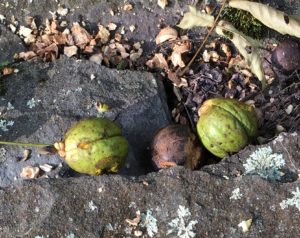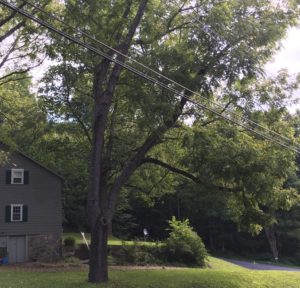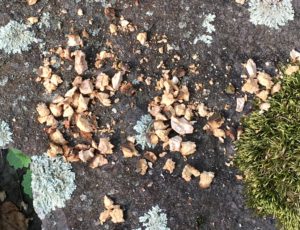Hello fellow readers,
One of the native trees that grace my yard is a shagbark hickory (Carya ovata). Its common name speaks for itself, with shaggy bark that stands out like a sculpture. But a treasure to some can be a nuisance to others. It’s true; the first time a golf ball-sized nut thumped my head, it was a stinging surprise. Then there’s the feeling of walking on marbles during the fall nut drop. Still, I’m glad the bear, fox, rabbits, squirrels, raccoons, and turkeys enjoy the nuts before tackling the cleanup, making the task far lighter to manage. We can eat shagbark nuts, too. They taste similar to pecans, which are also in the walnut plant family (Juglandaceae).
Juglone is a natural herbicide.
Shagbark hickory produces juglone, a natural herbicide, but in far less concentration than the Eastern Black Walnut (Juglans nigra), famous for being allelopathic – a fancy word for emitting chemicals that harm other plants. Juglone gives black walnuts a competitive advantage to non-tolerant plants within 50 to 80 feet.
While many plants suffer or die cohabitating around black walnuts such as everyday edibles like tomatoes, eggplant, potatoes, peppers, berries, plus woody plants such as rhododendron, lilacs, hydrangeas, privets, and pines, many plants will thrive.
Plants that thrive despite Juglone
Perennials and ground cover such as aster, astilbe, bee balm, black-eyed Susan, daylily, ferns, phlox, sweet woodruff, and pachysandra, to name a few, works well.
Woody plants such as Eastern redbud, Canadian hemlock, hickory, most maples, oaks, red cedar, forsythia, and most viburnum will do well too. You can find comprehensive lists of black walnut tolerant plants following the links below.
Black Walnuts can harm pets.
Recently I met with dog owners Rachel and Chip of Hardwick, NJ, who have a healthy population of black walnut trees, much to their chagrin. Though the nuts themselves do not harm dogs, it’s the nuts’ mold, if ingested, that can cause seizures. Horses exposed to black walnuts can suffer from laminitis resulting in pain and lameness as well. Hence it’s best to move nuts away from pets as soon as they drop, which does seem laborious. But it would be a shame to remove the magnificent native shade trees, with their fern-like foliage that turns brilliant yellow in fall and their showy, deeply ridged bark.
Black walnuts feed the same wildlife as shagbarks and are edible to those willing to tackle their husks. Woodworkers covet black walnut too. Perhaps it goes without saying, don’t add remnants from black walnut trees into your general use compost or mulch. And keep in mind – for every living thing, there is a great purpose.
Garden Dilemmas? AskMaryStone@gmail.com (and now on your favorite Podcast App.)
Click through to a related column, Fruits and Vegetables near Black Walnut.
And tune in to the Garden Dilemmas Podcast featuring this story.
Helpful Plant Lists tolerant of Black Walnut :
University of Wisconsin-Extension
Column updated 3/21/21





